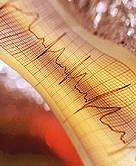'Wireless' pacemaker working well so far, researchers say

(HealthDay)—For a handful of patients who've received the first wire-free pacemaker, the results are still good after 18 months, researchers reported Wednesday.
Unlike traditional pacemakers, the new device—marketed as Nanostim—is completely self-contained and requires no wires to connect it to the heart muscle. It's also implanted through a catheter, which bypasses the need for a chest incision.
Nanostim and similar devices under development could "transform the field of cardiology in the next five to 10 years," said Dr. Ken Ellenbogen, an AHA spokesman and chairman of cardiology at the Medical College of Virginia, in Richmond.
The findings, presented at the annual meeting of the American Heart Association (AHA), are based on just eight patients. And, findings presented at meetings are generally considered preliminary until they've been published in a peer-reviewed journal. Still, experts said the new research adds to optimism about the new technology.
Although traditional pacemakers have a long history of working well, the new devices are expected to be even safer, said Ellenbogen, who was not involved in the new study.
Pacemakers help control certain abnormal heart rhythms, by sending electrical impulses to the heart muscle.
Conventional pacemakers, Ellenbogen explained, consist of a battery-powered pulse generator—which is placed under the skin of the chest—and insulated wires called "leads." Those leads run through the blood vessels to connect the generator to the heart.
Usually, the devices work well for years, Ellenbogen said. But the leads can occasionally malfunction, break or dislodge, or the area around the pulse generator or leads can become infected.
The Nanostim device is implanted directly into the wall of the right ventricle, one of heart's lower chambers.
"These leadless pacemakers are tiny—a little bigger than a penny," Ellenbogen said. "It's really remarkable that all of the circuitry can be contained within them."
Nanostim is already approved in Europe. The device doesn't yet have approval in the United States because the U.S. Food and Drug Administration has stricter requirements for approving new devices, Ellenbogen said.
At the AHA meeting, Dr. Fleur Tjong, from the Academic Medical Center in Amsterdam, presented the latest findings on eight patients who were part of an initial feasibility study that enrolled 33 patients. The work is being funded by device maker St. Jude Medical.
So far, the patients—whose average age is 82—have been followed for 18 months, and the leadless pacemaker is performing "as expected," with no complications, according to Tjong.
But as with any new technology, she said, studies need to keep monitoring how patients fare in the long term. One question, Tjong said, is whether the pacemaker can be easily retrieved when the battery begins to run low and the device needs to be replaced.
According to St. Jude, the pacemaker battery lasts eight years or more. Since the devices are new to the market, no one knows if removing them after a decade or so will be challenging, Tjong said.
If they can't be retrieved easily, she noted, another option would be to implant a second pacemaker.
Studies aimed at U.S. approval for Nanostim are underway, and according to Ellenbogen, that could happen within the next couple of years. But, he said, the transition to leadless will be "slow."
"You're not going to suddenly see 100 percent of implanted pacemakers be leadless," Ellenbogen said.
Tjong made the same point. For one, she explained, the current product is only for people who need pacing for just one heart chamber—and that's a minority of pacemaker candidates.
Most patients need what doctors call dual-chamber pacemakers, which help coordinate the upper and lower chambers of the heart. Researchers are working on leadless technology for those patients, too, Tjong said. But it's not a reality yet.
More information: The AHA has more information on pacemakers.
Copyright © 2014 HealthDay. All rights reserved.



















